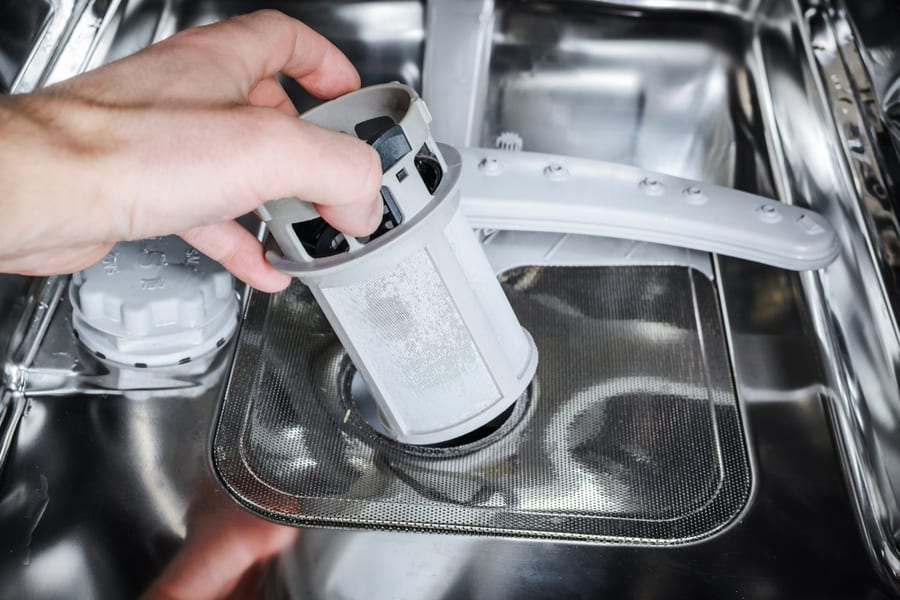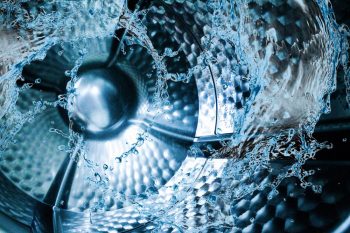
A dishwasher is a convenient appliance that saves us a lot of time and effort in cleaning our dishes. However, like any other appliance, it requires regular maintenance to ensure it continues to work efficiently.
One of the essential components of a dishwasher is its heating element, which helps to heat the water to the required temperature for effective cleaning.
Over time, the heating element can become dirty and covered in mineral deposits, affecting its performance.
In this guide, we will outline three different methods that you can use to clean your dishwasher’s heating element and keep it in good working order.
We’ve got you covered whether you prefer a natural or chemical-based approach. So, let’s get started!
Here are a few key points discussed in this article:
- Cleaning your dishwasher’s heating element is important for maintaining the efficiency of your dishwasher.
- You can use different methods to clean your dishwasher’s heating element, including baking soda and vinegar solution, citric acid and calcium-lime-rust remover, and a razor blade.
- Always turn off the power to your dishwasher before attempting to clean the heating element.
- Regularly inspect and clean your dishwasher’s filter and spray arms to prevent debris from getting trapped and causing buildup on the heating element.
- Use hot water and the appropriate amount of detergent to help prevent buildup on the heating element.
- It’s important to address any signs of damage or corrosion on the heating element, such as discoloration or rust, and address these issues promptly to prevent further damage.
Are you noticing that your dishes aren’t coming out as clean as they used to? Does your dishwasher seem to be running less efficiently than it once did? Are you detecting a strange odor coming from your dishwasher?
If you’ve answered yes to these questions, it may be time to clean your dishwasher’s heating element. In this guide, we’ll show you how to do it step-by-step using different methods so you can restore your dishwasher’s performance and get your dishes sparkling clean again.
Method 1: Clean the Dishwasher Heating Element With Vinegar and Baking Soda

The first method you can use to clean your dishwasher’s heating element is a natural approach.
To do this, you’ll need the following:
- White vinegar
- Baking soda
- Soft-bristled brush
- Clean cloth
1. Empty and Unplug the Dishwasher
Before cleaning, the first step is to unplug the appliance from its power source to ensure your safety.
2. Pour White Vinegar Into the Dishwasher
Take a cup of white vinegar and pour it into the bottom of the dishwasher. The vinegar will help to dissolve mineral deposits, grease, and soap scum from the heating element.
3. Sprinkle Baking Soda Into the Dishwasher
Sprinkle baking over the vinegar. Baking soda is a natural abrasive that will help remove stubborn stains and odors.
Let the mixture sit for 10-20 minutes. This will give it enough time to work its magic and loosen dirt buildup.
4. Scrub the Heating Element
After the mixture sits for 10-15 minutes, gently scrub the heating element with a soft-bristled brush.
Be careful not to use any abrasive materials or metal brushes, as they can scratch the surface of the heating element.
5. Run the Dishwasher on the Hot Cycle
After scrubbing the heating element, set your dishwasher on the hottest cycle possible. This will help to remove any remaining debris or residue.
This will also help to sanitize not only the dishwasher heating element but also the walls, arms, and other parts that may have come into contact with the vinegar and baking soda mixture.
6. Inspect and Repeat if Necessary
After running the dishwasher on the hot cycle, inspect the heating element and other parts to ensure they are completely clean and buildup-free.
You may need to repeat the cleaning process if you notice any remaining buildup or stains.
Once you’re satisfied with the cleanliness of the heating element and other parts, wipe the heating element one last time with a clean cloth to remove any remaining moisture.
Method 2: Clean the Dishwasher Heating Element With Citric Acid or CLR

If you prefer a more heavy-duty approach, use citric acid or CLR to clean your dishwasher’s heating element.
To do this, you’ll need the following:
- Citric acid or Calcium-Lime-Rust Remover (CLR)
- Soft-bristled brush
- Clean cloth
1. Empty and Unplug the Dishwasher
Before cleaning, ensure your dishwasher is empty and unplugged to avoid accidents.
2. Dissolve the Citric Acid in Water or Use CLR
You can use citric acid or Calcium-Lime-Rust Remover (CLR) for this step. Dissolve 10 tablespoons of citric acid in 2 liter water if using citric acid.
If using CLR, follow the manufacturer’s instructions for dilution and usage.
3. Pour the Solution Onto the Heating Element
Pour the citric acid solution or CLR onto the heating element. Make sure that the solution covers the heating element entirely.
4. Let It Sit for a Few Minutes
Allow the solution to sit on the heating element for a few minutes. This will give it time to dissolve any mineral deposits or buildup on the heating element. Leave the citric acid for at least 15 minutes.
For CLR, please do not leave it on for longer than 2 minutes.
5. Scrub the Heating Element
Using a soft-bristled brush, gently scrub the heating element to remove any remaining dirt or grime.
Be careful not to use any abrasive materials or metal brushes, as they can scratch the surface of the heating element.
6. Run a Rinse Cycle
Once the heating element has been cleaned, run a rinse cycle to flush out any residue left behind.
If the heating element is still dirty, repeat steps 2-5 with a new solution. Once the heating element is clean, your dishwasher can clean dishes more efficiently.
If using citric acid does not work, use Calcium-Lime-Rust remover (CLR) as an alternative. CLR is a strong cleaning agent that effectively removes mineral buildup on the heating elements.
However, following the manufacturer’s instructions carefully and wearing protective gloves and eye protection when using it is important.
Method 3: Remove the Melted Plastic Using a Razor Blade

If melted plastic is stuck to the heating element, you can use a razor blade to remove it.
To do this, you’ll need the following:
- Razor blade
- Ice cubes
- Baking Soda
- Lemon
- Dish soap
- Warm water
- Clean cloth
1. Empty and Unplug the Dishwasher
Before starting the cleaning process, the first step is to unplug and empty the dishwasher.
2. Let the Heating Element Cool Down
Suppose the heating element is still hot from the dishwasher cycle. Please wait for it to cool down completely before removing the melted plastic.
3. Use a Plastic Bag Filled With Ice Cubes
Once the heating element cools down, place the plastic bag filled with ice cubes over it and let it sit for 20-30 minutes. The ice cubes will help harden the melted plastic and make removing it easier.
4. Scrape Off the Plastic With a Razor Blade
Carefully scrape the hardened plastic from the heating element using a razor blade. Hold the blade at a low angle to avoid scratching the surface of the heating element.
Be sure to use gentle pressure and avoid applying too much force.
5. Clean the Heating Element
After removing the melted plastic, cleaning the heating element thoroughly is essential. To do this, mix baking soda with some water to create a paste.
Apply the paste to the heating element and leave it for a few minutes.
Cut the lemon in half and rub it gently over the paste. The citric acid in the lemon will help break down any remaining residue and clean the heating element.
Before plugging the dishwasher back in, it’s essential to clean the dishwasher thoroughly.
Mix a small amount of dish soap with warm water and use a clean cloth to wipe down the dishwasher’s walls, racks, and spray arms.
6. Run a Hot Cycle
Once you have cleaned the heating element and the inside of the dishwasher, run a hot cycle. This will help wash any remaining residue away, leaving your dishwasher clean and ready to use.
Be sure to wear protective gloves when using a razor blade, and be very careful not to scratch the surface of the heating element.
If you are uncomfortable using a razor blade, calling a professional for help is better.
How To Prevent Buildup on the Dishwasher Heating Element?

Here are a few tips to prevent grease and mineral buildup on the Dishwasher Heating Element:
- Scrape food particles off dishes before loading them into the dishwasher. This will prevent food particles from sticking to the heating element during the washing cycle.
- Ensure you’re using the appropriate amount of dishwasher detergent for your load size, as using too little can result in leftover grease, and using too much can leave a soapy residue.
- Consider using a water softener if you have hard water, as hard water can lead to mineral buildup on the heating element.
- Check the dishwasher’s filter and clean it regularly, as a clogged filter can lead to buildup on the heating element.
- Run your dishwasher regularly to prevent the buildup of mold and bacteria that can clog the heating element. If you don’t use your dishwasher frequently, consider running an empty cycle with a cup of vinegar to keep it clean.
- Use a rinse aid to help prevent buildup and ensure dishes come out clean.
- Use a dishwasher cleaner periodically to clean the racks, spray arms, detergent dispenser, and other parts to prevent food particles and debris from getting trapped and causing a buildup. Check your dishwasher’s manual for instructions on removing and cleaning these parts.
- Lastly, inspect your dishwasher’s heating element and other parts regularly for any signs of damage or corrosion. If you notice any problems, it’s important to have them repaired or replaced by a professional to prevent further damage to your dishwasher.
Following these steps, you can help remove dirt buildup and odors from your dishwasher and keep it fresh and clean.
Conclusion
Cleaning your dishwasher’s heating element is essential to maintaining and ensuring it works efficiently.
Using the methods outlined in this article, you can effectively remove buildup and debris from your heating element and prevent further damage or corrosion.
Additionally, following the tips will help you prevent buildup from occurring in the first place, keeping your dishwasher clean and functioning properly.
With a little regular maintenance and care, you can extend the life of your dishwasher and keep it running smoothly for years to come.
Frequently Asked Questions
What Does a Dishwasher Heating Element Do?
A dishwasher heating element is responsible for heating the water inside the dishwasher to a high temperature to properly clean and sanitize the dishes.
The high temperature helps to dissolve food particles, remove grease and grime, and kill bacteria and other harmful microorganisms.
The heating element is typically located at the bottom of the dishwasher and may be exposed or covered by a metal plate or other material.
Without a functioning heating element, a dishwasher may be unable to effectively clean and sanitize dishes, leading to unsanitary conditions and potential health risks.
How Often Do I Need To Clean My Dishwasher’s Heating Element?
The frequency with which you need to clean your dishwasher’s heating element will depend on how often you use your dishwasher and the hardness of your water.
Suppose you use your dishwasher regularly and have hard water.
In that case, it’s recommended that you clean the heating element once a month to prevent buildup and ensure the proper functioning of your dishwasher.
However, if you have soft water and don’t use your dishwasher as often, you may be able to clean the heating element less frequently.











